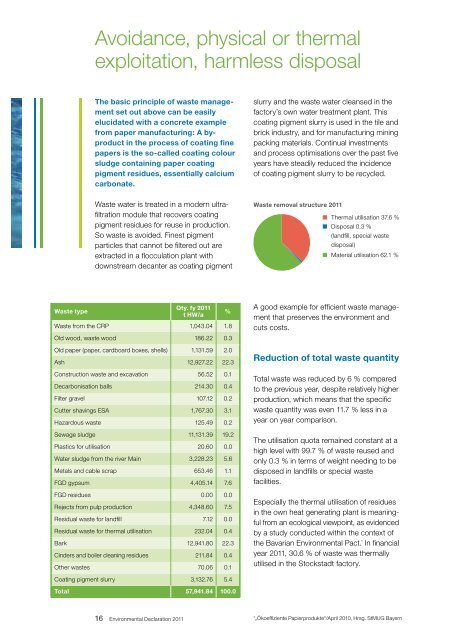Environmental Declaration 2011 - Sappi
Environmental Declaration 2011 - Sappi
Environmental Declaration 2011 - Sappi
Create successful ePaper yourself
Turn your PDF publications into a flip-book with our unique Google optimized e-Paper software.
Waste type<br />
Avoidance, physical or thermal<br />
exploitation, harmless disposal<br />
The basic principle of waste management<br />
set out above can be easily<br />
elucidated with a concrete example<br />
from paper manufacturing: A by-<br />
product in the process of coating fine<br />
papers is the so-called coating colour<br />
sludge containing paper coating<br />
pigment residues, essentially calcium<br />
carbonate.<br />
Waste water is treated in a modern ultrafiltration<br />
module that recovers coating<br />
pigment residues for reuse in production.<br />
So waste is avoided. Finest pigment<br />
particles that cannot be filtered out are<br />
extracted in a flocculation plant with<br />
downstream decanter as coating pigment<br />
Qty. fy <strong>2011</strong><br />
t HW/a<br />
Waste from the CRP 1,043.04 1.8<br />
Old wood, waste wood 186.22 0.3<br />
Old paper (paper, cardboard boxes, shells) 1,131.59 2.0<br />
Ash 12,927.22 22.3<br />
Construction waste and excavation 56.52 0.1<br />
Decarbonisation balls 214.30 0.4<br />
Filter gravel 107.12 0.2<br />
Cutter shavings ESA 1,767.30 3.1<br />
Hazardous waste 125.49 0.2<br />
Sewage sludge 11,131.39 19.2<br />
Plastics for utilisation 20.60 0.0<br />
Water sludge from the river Main 3,228.23 5.6<br />
Metals and cable scrap 653.46 1.1<br />
FGD gypsum 4,405.14 7.6<br />
FGD residues 0.00 0.0<br />
Rejects from pulp production 4,348.60 7.5<br />
Residual waste for landfill 7.12 0.0<br />
Residual waste for thermal utilisation 232.04 0.4<br />
Bark 12,941.80 22.3<br />
Cinders and boiler cleaning residues 211.84 0.4<br />
Other wastes 70.06 0.1<br />
Coating pigment slurry 3,132.76 5.4<br />
Total 57,941.84 100.0<br />
16 <strong>Environmental</strong> <strong>Declaration</strong> <strong>2011</strong><br />
%<br />
slurry and the waste water cleansed in the<br />
factory’s own water treatment plant. This<br />
coating pigment slurry is used in the tile and<br />
brick industry, and for manufacturing mining<br />
packing materials. Continual investments<br />
and process optimisations over the past five<br />
years have steadily reduced the incidence<br />
of coating pigment slurry to be recycled.<br />
Waste removal structure <strong>2011</strong><br />
n Thermal utilisation 37.6 %<br />
n Disposal 0.3 %<br />
(landfill, special waste<br />
disposal)<br />
n Material utilisation 62.1 %<br />
A good example for efficient waste management<br />
that preserves the environment and<br />
cuts costs.<br />
Reduction of total waste quantity<br />
Total waste was reduced by 6 % compared<br />
to the previous year, despite relatively higher<br />
production, which means that the specific<br />
waste quantity was even 11.7 % less in a<br />
year on year comparison.<br />
The utilisation quota remained constant at a<br />
high level with 99.7 % of waste reused and<br />
only 0.3 % in terms of weight needing to be<br />
disposed in landfills or special waste<br />
facilities.<br />
Especially the thermal utilisation of residues<br />
in the own heat generating plant is meaning<br />
ful from an ecological viewpoint, as evidenced<br />
by a study conducted within the context of<br />
the Bavarian <strong>Environmental</strong> Pact. * In financial<br />
year <strong>2011</strong>, 30.6 % of waste was thermally<br />
utilised in the Stockstadt factory.<br />
*„Ökoeffiziente Papierprodukte“/April 2010, Hrsg. StMUG Bayern

















